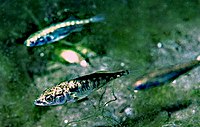
Photo from wikipedia
Evidence of contemporary evolution across ecological time scales stimulated research on the eco‐evolutionary dynamics of natural populations. Aquatic systems provide a good setting to study eco‐evolutionary dynamics owing to a… Click to show full abstract
Evidence of contemporary evolution across ecological time scales stimulated research on the eco‐evolutionary dynamics of natural populations. Aquatic systems provide a good setting to study eco‐evolutionary dynamics owing to a wealth of long‐term monitoring data and the detected trends in fish life‐history traits across intensively harvested marine and freshwater systems. In the present study, we focus on modelling approaches to simulate eco‐evolutionary dynamics of fishes and their ecosystems. Firstly, we review the development of modelling from single species to multispecies approaches. Secondly, we advance the current state‐of‐the‐art methodology by implementing evolution of life‐history traits of a top predator into the context of complex food web dynamics as described by the allometric trophic network (ATN) framework. The functioning of our newly developed eco‐evolutionary ATNE framework is illustrated using a well‐studied lake food web. Our simulations show how both natural selection arising from feeding interactions and size‐selective fishing cause evolutionary changes in the top predator and how those feed back to its prey species and further cascade down to lower trophic levels. Finally, we discuss future directions, particularly the need to integrate genomic discoveries into eco‐evolutionary projections.
Journal Title: Evolutionary Applications
Year Published: 2020
Link to full text (if available)
Share on Social Media: Sign Up to like & get
recommendations!